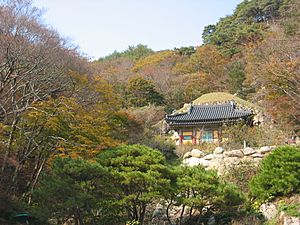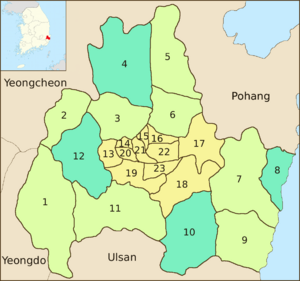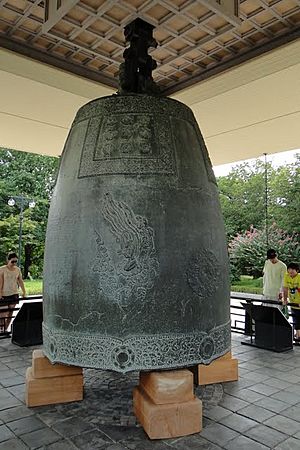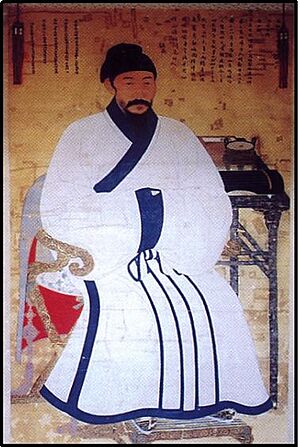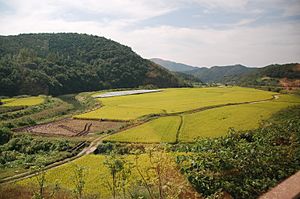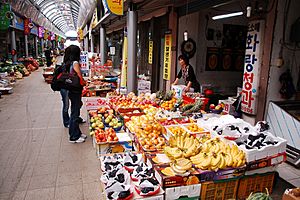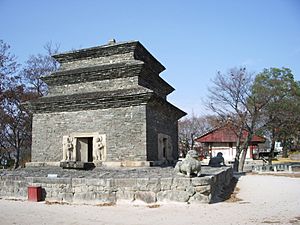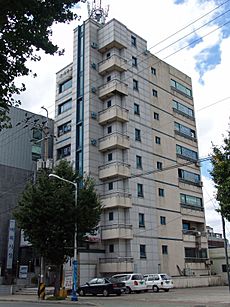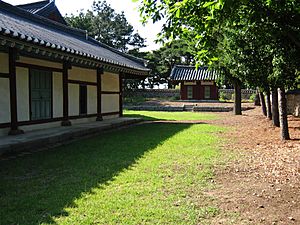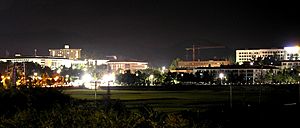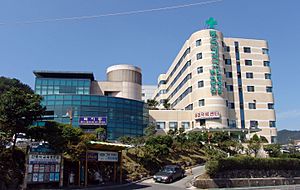Gyeongju facts for kids
Quick facts for kids
Gyeongju
경주시
|
|||
|---|---|---|---|
| Korean transcription(s) | |||
| • Hangul | 경주시 | ||
| • Hanja | 慶州市 | ||
| • Revised Romanization | Gyeongju-si | ||
| • McCune-Reischauer | Kyŏngju-si | ||

Top left: Donggung Palace and Wolji Pond; Top right: Bell of King Seongdeok; middle left: Seokguram; middle right:Bulguksa temple; bottom left: Yangdong Folk Village; bottom right: Cheomseongdae.
|
|||
|
|||

Location in South Korea
|
|||
| Country | |||
| Region | North Gyeongsang Province | ||
| Founded | 57 BC | ||
| Administrative divisions | 4 eup, 8 myeon, 11 dong, 305 ri | ||
| Area | |||
| • Total | 1,324.39 km2 (511.35 sq mi) | ||
| Population
(November, 2022)
|
|||
| • Total | 249,845 | ||
| • Density | 212/km2 (550/sq mi) | ||
| • Dialect | Gyeongsang | ||
| Demonym(s) | Gyeongjuite | ||
| Time zone | UTC+9 (Korea Standard Time) | ||
| Area code(s) | +82-54 | ||
| Website | City of Gyeongju | ||
Gyeongju (Korean: 경주) is a city on the coast in the southeastern part of North Gyeongsang Province, South Korea. It's the second largest city in the province by land area. Gyeongju is about 370 kilometers (230 miles) southeast of Seoul, the capital of South Korea.
For nearly 1,000 years, Gyeongju was the capital of the ancient kingdom of Silla (57 BC – 935 AD). This kingdom ruled over two-thirds of the Korean peninsula. During its peak, Gyeongju was a very rich and important city, even one of the largest in the world. Today, you can still see many old buildings and historical sites from that time. Because of all its historical treasures, Gyeongju is often called "the museum without walls."
Some of Gyeongju's most famous historical sites are Seokguram grotto, Bulguksa temple, Gyeongju Historic Areas, and Yangdong Folk Village. These places are so important that UNESCO has named them World Heritage Sites. This makes Gyeongju a very popular place for tourists in South Korea.
Today, Gyeongju is a mix of city and rural areas. While tourism is a big part of its economy, manufacturing has also grown. This is because Gyeongju is close to big industrial cities like Ulsan and Pohang. The city is also well-connected by trains and highways, making it easy for both businesses and tourists to travel there.
Contents
- Exploring Gyeongju's Past
- Gyeongju's Natural Surroundings
- How Gyeongju is Organized
- People and Culture of Gyeongju
- Sports and Fun in Gyeongju
- Gyeongju's Economy
- Visiting Gyeongju: A Tourist's Guide
- News and Entertainment in Gyeongju
- Learning and Education in Gyeongju
- Gyeongju's Essential Services
- Gyeongju's Sister Cities
- See also
Exploring Gyeongju's Past
The story of Gyeongju is closely connected to the Silla kingdom. It was the capital city for almost 1,000 years! In the beginning, around 57 BCE, six small villages in the Gyeongju area joined together. This was the start of the Silla kingdom. As the kingdom grew, its capital city was known by different names like "Seorabeol," "Gyerim," or "Geumseong."
After Silla united the Korean peninsula in 668 AD, Gyeongju became the most important city in Korea. It was where the Silla kings lived and where most of the kingdom's important people were. The city was so rich and famous that people even in faraway Persia heard about it. Historical records say that at its busiest time, Gyeongju had nearly one million people living there! Many of the famous historical sites you see in Gyeongju today are from this time.
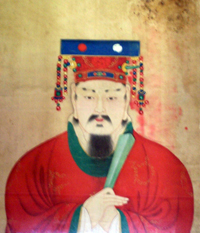
In 940, the founder of the next kingdom, Goryeo, changed the city's name to "Gyeongju," which means "Congratulatory district." Gyeongju was even called "Donggyeong" (meaning "East Capital") for a while. However, it later lost its status as a capital city. Over the centuries, Gyeongju faced many challenges. In the 13th century, Mongol forces caused damage to some temples. Later, during the Japanese invasions, parts of Gyeongju became battlefields, and some wooden buildings were burned.
In the 20th century, Gyeongju remained a smaller city. Many archaeological digs were done, especially in the old tombs, which helped uncover amazing artifacts. A museum was opened in 1915 to show these treasures. Gyeongju also became a railroad hub during the Japanese occupation, connecting different parts of the country. After Korea became free in 1945, there was some unrest, but Gyeongju was mostly safe during the Korean War in the 1950s.
In the 1970s, South Korea saw a lot of industrial growth. Gyeongju, being close to big industrial areas like Ulsan and Pohang, also started to develop its own factories and businesses.
Gyeongju's Natural Surroundings
Gyeongju is located in the southeastern part of North Gyeongsang Province. It shares borders with other cities and counties like Ulsan to the south and Pohang to the north. To the east, Gyeongju meets the Sea of Japan.
The city is surrounded by many low mountains, which are part of the Taebaek Mountains. The highest point in Gyeongju is Munbok Mountain, which is 1,015 meters (3,330 feet) tall. Other mountains like Toham Mountain are also important.
These mountains shape how rivers flow in Gyeongju. The main river is the small Hyeongsan River, which flows north from Ulsan and reaches the sea at Pohang. The Hyeongsan River has smaller rivers like the Bukcheon and Namcheon joining it in the Gyeongju Basin.
Gyeongju has a coastline that stretches for about 36 kilometers (22 miles). There are no big islands or large bays, but there are 12 small harbors.
Gyeongju's Weather Patterns
Gyeongju has a climate with hot summers and cool winters. It also has a monsoon season from late June to early August, which means it gets a lot of rain then. Sometimes, typhoons can hit the coast in autumn. On average, Gyeongju gets about 1,091 millimeters (43 inches) of rain each year. The average high temperatures range from 8.6°C (47.5°F) in winter to 31.1°C (88.0°F) in summer.
The city center, which is in a low-lying area, has experienced floods many times in history, often because of typhoons. However, modern flood control systems have greatly reduced this problem.
| Climate data for Gyeongju (2011–2020 normals, extremes 2010–present) | |||||||||||||
|---|---|---|---|---|---|---|---|---|---|---|---|---|---|
| Month | Jan | Feb | Mar | Apr | May | Jun | Jul | Aug | Sep | Oct | Nov | Dec | Year |
| Record high °C (°F) | 16.8 (62.2) |
24.2 (75.6) |
26.6 (79.9) |
32.5 (90.5) |
36.2 (97.2) |
36.5 (97.7) |
39.7 (103.5) |
39.8 (103.6) |
35.1 (95.2) |
31.5 (88.7) |
29.4 (84.9) |
19.3 (66.7) |
39.8 (103.6) |
| Mean daily maximum °C (°F) | 5.9 (42.6) |
8.4 (47.1) |
14.4 (57.9) |
19.7 (67.5) |
25.7 (78.3) |
27.7 (81.9) |
30.6 (87.1) |
31.4 (88.5) |
26.2 (79.2) |
21.6 (70.9) |
15.3 (59.5) |
7.7 (45.9) |
19.6 (67.3) |
| Daily mean °C (°F) | 0.3 (32.5) |
2.3 (36.1) |
7.4 (45.3) |
12.7 (54.9) |
18.4 (65.1) |
21.9 (71.4) |
25.4 (77.7) |
25.9 (78.6) |
20.5 (68.9) |
14.8 (58.6) |
8.7 (47.7) |
1.9 (35.4) |
13.4 (56.1) |
| Mean daily minimum °C (°F) | −4.7 (23.5) |
−3.1 (26.4) |
1.0 (33.8) |
6.0 (42.8) |
11.7 (53.1) |
17.0 (62.6) |
21.4 (70.5) |
21.9 (71.4) |
16.2 (61.2) |
9.3 (48.7) |
3.0 (37.4) |
−3.2 (26.2) |
8.0 (46.4) |
| Record low °C (°F) | −14.7 (5.5) |
−13.4 (7.9) |
−6.6 (20.1) |
−3.0 (26.6) |
1.9 (35.4) |
10.2 (50.4) |
14.9 (58.8) |
14.0 (57.2) |
7.0 (44.6) |
−0.6 (30.9) |
−6.6 (20.1) |
−11.7 (10.9) |
−14.7 (5.5) |
| Average precipitation mm (inches) | 32.2 (1.27) |
30.8 (1.21) |
59.7 (2.35) |
96.1 (3.78) |
55.3 (2.18) |
100.6 (3.96) |
190.1 (7.48) |
191.9 (7.56) |
194.1 (7.64) |
108.2 (4.26) |
37.8 (1.49) |
24.4 (0.96) |
1,121.2 (44.14) |
| Average precipitation days (≥ 0.1 mm) | 5.1 | 6.8 | 7.6 | 9.8 | 7.7 | 9.6 | 12.8 | 13.7 | 12.2 | 6.7 | 6.8 | 5.4 | 104.2 |
| Average relative humidity (%) | 52.6 | 56.7 | 58.3 | 60.3 | 63.5 | 72.6 | 78.4 | 79.8 | 81.3 | 75.1 | 67.5 | 56.3 | 66.9 |
| Mean monthly sunshine hours | 197.2 | 179.1 | 226.7 | 218.8 | 240.0 | 182.1 | 162.9 | 180.9 | 147.5 | 178.5 | 161.8 | 186.2 | 2,261.7 |
| Source: Korea Meteorological Administration | |||||||||||||
How Gyeongju is Organized
Gyeongju is divided into 23 administrative areas: 4 eup (towns), 8 myeon (rural townships), and 11 dong (neighborhoods). The dong areas are in the city center, while eup are larger villages and myeon are more rural.
The city's borders have changed over time. From 1895 to 1955, it was called Gyeongju-gun (Gyeongju County). In 1931, the downtown area became Gyeongju-eup, meaning it was becoming more urban. In 1955, Gyeongju-eup became Gyeongju-si (Gyeongju City), but it was much smaller than today. The rest of the county was called "Wolseong County." In 1995, the city and county reunited to form Gyeongju City as we know it now.
| Map of Gyeongju | |||||||||
|---|---|---|---|---|---|---|---|---|---|
| # | Place | Population (2007) |
Households | Area (km2) |
# | Place | Population |
Households | Area (km2) |
| 1 | Sannae-myeon | 3,561 | 1,779 | 142.6 | 13 | Seondo-dong | 13,813 | 2,831 | 28.0 |
| 2 | Seo-myeon | 4,773 | 1,779 | 52.1 | 14 | Seonggeon-dong | 18,378 | 7,562 | 6.4 |
| 3 | Hyeongok-myeon | 16,829 | 5,726 | 55.7 | 15 | Hwangseong-dong | 29,660 | 9,415 | 3.8 |
| 4 | Angang-eup | 33,802 | 12,641 | 138.6 | 16 | Yonggang-dong | 15,959 | 5,244 | 5.1 |
| 5 | Gangdong-myeon | 8,834 | 3,659 | 81.4 | 17 | Bodeok-dong | 2,296 | 977 | 81.0 |
| 6 | Cheonbuk-myeon | 6,185 | 2,328 | 58.2 | 18 | Bulguk-dong | 9,001 | 3,722 | 37.4 |
| 7 | Munmudaewang-myeon | 4,535 | 2,026 | 120.1 | 19 | Hwangnam-dong* | 8,885 | 3,875 | 20.5 |
| 8 | Gampo-eup | 7,099 | 3,084 | 44.9 | 20 | Jungbu-dong | 7,003 | 3,022 | 0.9 |
| 9 | Yangnam-myeon | 7,131 | 2,941 | 85.1 | 21 | Hwango-dong* | 10,225 | 4283 | 1.5 |
| 10 | Oedong-eup | 19,006 | 6,965 | 109.8 | 22 | Dongcheon-dong | 26,721 | 9,228 | 5.3 |
| 11 | Naenam-myeon | 6,142 | 2,526 | 122.1 | 23 | Wolseong-dong | 6,522 | 4,842 | 31.4 |
| 12 | Geoncheon-eup | 11,217 | 4,533 | 92.4 | |||||
|
*Figures based on resident registration figures made available by local government offices. For more detailed source information, see Subdivisions of Gyeongju. |
People and Culture of Gyeongju
Gyeongju's Population Today
Back when Silla was at its strongest, Gyeongju might have had a million people living there. That's four times more than today! In recent years, Gyeongju's population has been changing, just like the rest of South Korea. Families are getting smaller, and the population is getting older.
Like many smaller cities in South Korea, Gyeongju has seen its population decrease a bit. This is mostly because people move to bigger cities for jobs. However, more babies are born than people pass away each year, which helps balance things out a little.
Gyeongju also has a growing number of people from other countries. Many of them come from other Asian countries and work in factories, especially in the car parts industry.
The Unique Gyeongju Dialect
People in Gyeongju speak a special dialect that is also heard in northern parts of Ulsan. It's similar to the general Gyeongsang dialect but has its own unique sounds. Some language experts believe that these special features might be leftovers from the ancient Silla language.
Cultural Treasures of Gyeongju
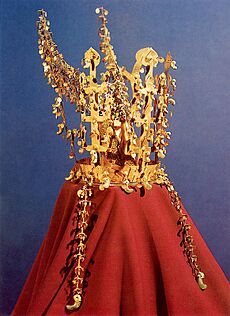
Gyeongju is a top spot in South Korea for anyone interested in the history of Silla and old Korean buildings. The city is home to 31 National Treasures, which are super important historical items. The Gyeongju National Museum alone has over 16,000 artifacts!
You can find many types of historical sites here:
- Ancient Tombs: There are 35 royal tombs and 155 other burial mounds in central Gyeongju. These mounds, called tumuli, hold amazing artifacts from the Silla period. For example, a beautiful gold crown was found in the Gold Crown Tomb.
- Buddhist Sites: Many places are related to Buddhism, which was very important in Silla. Bulguksa is one of South Korea's biggest Buddhist temples. Nearby is Seokguram, a famous Buddhist shrine carved into a grotto. Both are UNESCO World Heritage Sites. You can also find old stone carvings of Buddhas on the mountainsides, especially on Namsan.
- Fortresses and Palaces: You can see the remains of old fortresses and palace sites that tell us about how people lived long ago.
Even older remains, like pottery from the prehistoric era, have been found in Gyeongju. There are also Dolmens, which are ancient stone structures, in several places.
Famous People from Gyeongju
Gyeongju has been the home of many important people throughout history. During the Silla period, it was where kings, scholars like Seol Chong, and brave generals like Kim Yu-sin lived. Kim Yu-sin was a leader of the Hwarang warriors, who were very important in uniting the Korean peninsula.
Later, during the Goryeo and Joseon dynasties, Gyeongju continued to produce smart thinkers. In modern times, famous writers like Kim Dongni and Pak Mok-wol came from Gyeongju. They helped share the region's culture with more people.
Many Korean family clans, like the Gyeongju Kim clan, Gyeongju Park clan, and Gyeongju Seok clans, trace their family roots back to the Silla kings and important families in Gyeongju.
Religion in Gyeongju
Gyeongju is still a very important place for Korean Buddhism. Besides Bulguksa and Seokguram, you can find traditional prayer spots on mountains all around the city. Namsan mountain is even called "the sacred mountain" because of all the Buddhist shrines and statues on its slopes.
Gyeongju is also the birthplace of Cheondoism, a unique Korean religion. It started from the teachings of Choe Je-u. His birthplace, called Yongdamjeong, is a sacred place for people who follow Cheondogyo.
Delicious Food in Gyeongju
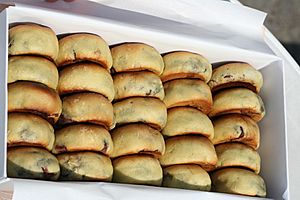
Gyeongju's food is similar to other areas in the Gyeongsang province, often spicy and salty. But it has its own special dishes! The most famous is "Gyeongju bread" or "Hwangnam bread." This is a sweet pastry filled with red bean paste, first made in 1939. Another local treat is Chalboribbang, a pastry made with local barley and red bean paste.
A traditional Korean alcoholic drink called beopju is also made in Gyeongju by the Gyeongju Choe family. The special way they make it is considered an Important Intangible Cultural Property by the South Korean government.

Since Gyeongju is on the coast, especially in the Gampo-eup area, you can find lots of fresh seafood. There are many seafood restaurants in Gampo Harbor that serve dishes like hoe (raw fish), abalone soup, and grilled seafood.
Sports and Fun in Gyeongju
Gyeongju has many places for sports, including stadiums, gyms, and swimming pools. Many of these public sports facilities are in Hwangseong Park. This park used to be a training ground for the hwarang warriors and a hunting spot for Silla kings. Today, it has the Gyeongju Public Stadium, a Football Park, a gym, and places for traditional Korean archery and ssireum wrestling.
Gyeongju also has a professional women's field hockey team called Gyeongju City Hockey. They train at the Angang Field Hockey Stadium. The team has won several championships!
The city hosts two annual marathon events. The Gyeongju International Marathon is for professional runners. The larger Gyeongju Cherry Blossom Marathon is for amateur runners and fun. This marathon has been held every April since 1992 and attracts thousands of participants, including many from other countries.
Gyeongju's Economy
Gyeongju's economy is quite varied. Even though tourism is very important, many people work in other areas. Over 27,000 people work in manufacturing, while about 13,500 work in hotels and restaurants. The manufacturing sector has grown a lot, especially because Gyeongju is connected to big industrial cities like Ulsan and Pohang. The car parts industry is a major part of Gyeongju's manufacturing.
Fishing is also important in coastal towns, especially in Gampo-eup. Many boats catch fish and seafood, which then go to Gyeongju's many seafood restaurants. Some local specialties include fermented anchovies, abalone, and squid.
Agriculture is still a key part of Gyeongju's economy, especially in the rural areas. Rice fields cover a large part of the cultivated land. Other important crops include barley, beans, corn, vegetables like radish and napa cabbage, and fruits like apples and Korean pears. Gyeongju is also known for producing beef and mushrooms.
Mining is a smaller industry in the city, mainly extracting materials like kaolin.
Because Gyeongju was the capital of Silla, trade and business started very early here. In ancient times, there were special markets in the city. Even in the 1830s, Gyeongju had busy markets that were famous in the region. Today, Gyeongju has both regular markets and traditional periodic markets where people can buy agricultural products, seafood, and other goods.
Visiting Gyeongju: A Tourist's Guide

Gyeongju is a very popular place for tourists, both from South Korea and other countries. It's famous for its 1,000 years of Silla history, with many ancient ruins and archaeological sites all over the city. About 6 million tourists visit Gyeongju each year. The city government also hosts conferences, festivals, and has resorts to attract more visitors.
Many Silla historical sites are part of Gyeongju National Park. These include:
- The Royal Tomb Complex, where ancient kings and queens are buried.
- The Cheomseongdae observatory, one of the oldest places in East Asia used to study the stars.
- The Anapji royal pond garden, a beautiful garden where Silla royalty relaxed.
- The Gyerim forest, a historic forest with old trees.
The Gyeongju National Museum is a must-see, as it displays many important artifacts and national treasures found in and around the city.
A lot of Gyeongju's history is linked to Buddhism, which the Silla kingdom supported. The Seokguram grotto and the Bulguksa temple were the first Korean sites to be added to the UNESCO World Heritage List in 1995. You can also see the ruins of the old Hwangnyongsa temple, which was once Korea's largest, on the slopes of Toham Mountain.
Gyeongju also hosts many festivals and events. The Silla cultural festival is held every October to celebrate the dynasty's history and culture. It's one of Korea's biggest festivals, with sports, folk games, music, dance, and Buddhist ceremonies. Other events include the Cherry Blossom Marathon in April and special ceremonies for Silla's founders.
Gyeongju has many hotels and lodging places, along with thousands of restaurants for visitors. A new popular spot is Hwangnidan-gil, a street with about 80 stores, including restaurants, cafes, bookstores, and gift shops. It became famous through social media and is close to Gyeongju's historical sites.
Top Tourist Spots in Gyeongju
| Donggung Palace and Wolji Pond |
| Gyeongju World Culture Expo Park |
| Yangdong Folk Village |
| Silla Oreung Tombs |
| Tohamsan |
| Gyeongju Gameunsa Temple Site |
| Gyeongju East Palace Garden (Donggungwon) |
| Gyeongju World |
| Gyeongju Gyochon Traditional Village |
| Gumisan Mountain |
| Girimsa Temple |
| Tomb of General Kim Yusin |
| Gyeongju Namsan Mountain |
| Danseoksan Mountain |
| Daereungwon Tomb Complex |
| Royal Tomb of King Taejong Muyeol |
| Bunhwangsa Temple |
| Bulguksa Temple |
| Seokguram Grotto |
| Sogeumgangsan Mountain |
| Silla Arts and Science Museum |
| Yangnam Jusangjeolli Cliff Observatory |
| Tongiljeon |
| Poseokjeong Pavilion |
News and Entertainment in Gyeongju
Gyeongju has two main local newspapers: the Gyeongju Sinmun and the Seorabeol Sinmun. Both are weekly newspapers that also share news online. The Gyeongju Sinmun started in 1989 and covers various topics about Gyeongju. It even gives out awards to people who help develop the local industry, culture, and welfare.
The Seorabeol Sinmun began in 1993. After a break due to financial difficulties, it started publishing again in 2005. It also gives awards to people who work to improve Gyeongju.
Several movies have been filmed in Gyeongju, including Kick the Moon and Taegukgi. The popular TV series Queen Seondeok was also filmed at a studio in Gyeongju.
Learning and Education in Gyeongju
Gyeongju has a long history of education, especially with the tradition of Hwarangdo ("Way of the Flower of Young Men") from the Silla period. This was a special training system for young noblemen, teaching them both academics and martial arts. Many great Silla generals, like Kim Yu-sin, were Hwarang.
Formal education began very early in Gyeongju. The Gukhak, a national academy, was set up here in 682. It taught Confucian classics to prepare people for government jobs. Later, under other dynasties, Gyeongju had provincial schools called hyanggyo and private Confucian academies called seowon, like Oksan Seowon.
Today, Gyeongju's education system is like the rest of South Korea. It has preschools, elementary schools, middle schools, and high schools. There are both public and private schools at each level.
Gyeongju is also home to four colleges and universities. Sorabol College is a technical college focusing on tourism and healthcare. Dongguk and Uiduk universities are Buddhist institutions, showing the city's connection to that religion. Gyeongju University focuses strongly on tourism, which is very important to the region.
Gyeongju's Essential Services
Healthcare for Residents
Gyeongju has many medical facilities, including hospitals, clinics, and dental offices. There are two main general hospitals. One is the Dongguk University Gyeongju Hospital, which is connected to Dongguk University. It opened in 1991 to provide good medical care and train doctors in the area. The other general hospital is a branch of Keimyung University's Dongsan Medical Hospital.
City Services and Utilities
The city government manages water supply and sewage disposal. Water comes from the Hyeongsan River and the Deokdong Dam. Gyeongju has several water treatment and sewage treatment plants to keep the water clean. One plant, the Angang Sewage Disposal Plant, helps prevent pollution in the Hyeongsan River, which is a main water source for Gyeongju and Pohang.
Other services like gas and electricity are provided by private companies or government-owned businesses. Korea Hydro & Nuclear Power supplies electricity from the Wolseong Nuclear Power Plant. This plant is known for using a special type of reactor and provides about 5% of South Korea's electricity. There's also a center nearby that handles low-level radioactive waste safely.
Getting Around Gyeongju
Gyeongju is well-connected by train and road. The Jungang Line train runs from Seoul to Gyeongju. The Gyeongbu Expressway, a major highway from Seoul to Busan, also passes through Gyeongju. Many national highways cross the city, making it easy to travel by car.
Since Gyeongju is a popular tourist spot, you can find direct bus services from most major cities in South Korea. While high-speed trains (KTX) don't stop in central Gyeongju, the KTX Gyeongbu Line has a station nearby in Geoncheon-eup, west of the city center.
Gyeongju's Sister Cities
Gyeongju has special partnerships with other cities around the world. These are called "sister cities" and they work together on cultural and other projects.
Gyeongju also cooperates with:
 Canberra, Australia
Canberra, Australia
See also
 In Spanish: Gyeongju para niños
In Spanish: Gyeongju para niños




